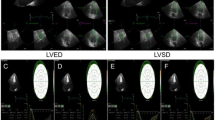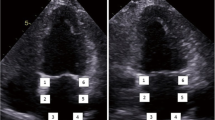Abstract
Pressure overload due to aortic stenosis leads to subclinical left ventricular (LV) dysfunction and global longitudinal strain (GLS) impairment even if ejection fraction is preserved. However, little is known about LV mechanics in aortic prosthetic valve (APV) stenosis. The study aimed to determine the role of myocardial strain and rotation in predicting prosthetic valve stenosis in mechanical APV patients. 60 patients with mechanical APV and 30 healthy individuals were evaluated. APV patients were analyzed in two groups; aortic valve mean gradient < 20 mmHg (27 normal gradient patients) and ≥ 20 mmHg (33 high gradient patients). Strain, rotation, and twist values were assessed using the speckle tracking method, and brain natriuretic peptide (BNP) levels were measured. Four-chamber (p < 0.001) and two-chamber (p = 0.008) longitudinal strain (LS) were higher in the control group. GLS was lower in the high gradient group than control and normal gradient groups (p < 0.001, p = 0.022). LS of lateral wall’s basal and mid segments were lower in normal and high gradient groups than the control group (p = 0.003, p = 0.008). While basal rotation was lower in the high gradient group than the control group (p = 0.048), there was no difference between the groups in terms of apical rotation, and twist. BNP levels were significantly different between the groups (p = 0.048). No correlation was found between aortic valve mean gradient and GLS, basal rotation, and BNP. In conclusions, LV GLS and basal rotation are depressed in high APV gradient patients; however, these parameters are not independent predictors of gradient increment.



Similar content being viewed by others
References
Baumgartner H, Falk V, Bax JJ et al (2017) ESC/EACTS guidelines for the management of valvular heart disease. Eur Heart J 38:2739–2791
Zoghbi WA, Chambers JB, Dumesnil JG et al (2009) Recommendations for evaluation of prosthetic valves with echocardiography and doppler ultrasound. J Am Soc Echocardiogr 22:975–1014
Gorcsan J 3rd, Tanaka H (2011) Echocardiographic assessment of myocardial strain. J Am Coll Cardiol 58:1401–1413
Potter E, Marwick TH (2018) Assessment of left ventricular function by echocardiography: the case for routinely adding global longitudinal strain to ejection fraction. JACC Cardiovasc Imaging 11:260–274
Carasso S, Mutlak D, Lessick J et al (2015) Symptoms in severe aortic stenosis are associated with decreased compensatory circumferential myocardial mechanics. J Am Soc Echocardiogr 28:218–225
D’Andrea A, Padalino R, Cocchia R et al (2015) Effects of transcatheter aortic valve implantation on left ventricular and left atrial morphology and function. Echocardiography 32:928–936
Vizzardi E, Sciatti E, Bonadei I et al (2014) Effects of transcatheter aortic valve implantation on left ventricular mass and global longitudinal strain: tissue doppler and strain evaluation. Heart Lung Vessel 6:253–261
Vollema EM, Singh GK, Prihadi EA et al (2019) Time course of left ventricular remodelling and mechanics after aortic valve surgery: aortic stenosis vs. aortic regurgitation. Eur Heart J Cardiovasc Imaging 20:1105–1111
Bergler-Klein J, Gyöngyösi M, Maurer G (2014) The role of biomarkers in valvular heart disease: focus on natriuretic peptides. Can J Cardiol 30:1027–1034
Lang RM, Badano LP, Mor-Avi V et al (2015) Recommendations for cardiac chamber quantification by echocardiography in adults: an update from the American Society of Echocardiography and the European Association of Cardiovascular Imaging. J Am Soc Echocardiogr 28:1–39
Voigt JU, Cvijic M (2019) 2- and 3-diemnional myocardial strain in cardiac health and disease. J Am Coll Cardiol Img 12:1849–1863
Stokke TM, Hasselberg NE, Smedsrud MK et al (2017) Geometry as a confounder when assessing ventricular systolic function: comparison between ejection fraction and strain. J Am Coll Cardiol 70:942–954
Rost C, Korder S, Wasmeier G et al (2010) Sequential changes in myocardial function after valve replacement for aortic stenosis by speckle tracking echocardiography. Eur J Echocardiogr 11:584–589
Noemi HA, Abuelatta R, Alatawi FO et al (2020) Assessment of left ventricular mechanics in patients with severe aortic stenosis after transcatheter aortic valve implantation: 2-D speckle tracking imaging study. J Saudi Heart Assoc 32:248–255
Ng AC, Delgado V, Bertini M et al (2011) Alterations in multidirectional myocardial functions in patients with aortic stenosis and preserved ejection fraction: a two-dimensional speckle tracking analysis. Eur Heart J 32:1542–1550
Naji P, Shah S, Svensson LG et al (2017) Incremental prognostic use of left ventricular global longitudinal strain in asymptomatic/minimally symptomatic patients with severe bioprosthetic aortic stenosis undergoing redo aortic valve replacement. Circ Cardiovasc Imaging 10(6):e005942. https://doi.org/10.1161/CIRCIMAGING.116.005942
Ösken A, Dayı ŞÜ, Özcan KS et al (2021) Speckle tracking echocardiography in severe patient–prosthesis mismatch. Herz. https://doi.org/10.1007/s00059-021-05031-4
Attias D, Macron L, Dreyfus J et al (2013) Relationship between longitudinal strain and symptomatic status in aortic stenosis. J Am Soc Echocardiogr 26:868–874
Tongue AG, Dumesnil JG, Laforest I et al (2003) Left ventricular longitudinal shortening in patients with aortic stenosis: relationship with symptomatic status. J Heart Valve Dis 12:142–149
Nagel E, Stuber M, Burkhard B et al (2000) Cardiac rotation and relaxation in patients with aortic valve stenosis. Eur Heart J 21:582–589
Van Dalen BM, Tzikas A, Soliman OI et al (2011) Left ventricular twist and untwist in aortic stenosis. Int J Cardiol 148:319–324
Lindqvist P, Zhao Y, Bajraktari G et al (2011) Aortic valve replacement normalizes left ventricular twist function. Interact Cardiovasc Thorac Surg 12:701–706
Naeim HA, Abuelatta R, Alatawi FO et al (2020) Assessment of left ventricular mechanics in patients with severe aortic stenosis after transcatheter aortic valve implantation: 2-D speckle tracking imaging study. J Saudi Heart Assoc 32:248–255
Gerber IL, Stewart RA, Legget ME et al (2003) Increased plasma natriuretic peptide levels reflect symptom onset in aortic stenosis. Circulation 107:1884–1890
Clavel MA, Malouf J, Michelena HI et al (2014) B-Type natriuretic peptide clinical activation in aortic stenosis. J Am Coll Cardiol 63:2016–2025
Poulsen SH, Sogaard P, Nielsen- Kudsk JE et al (2007) Recovery of the left ventricular systolic longitudinal strain after valve replacement in aortic stenosis and relation to natriuretic peptides. J Am Soc Echocardiorg 20:877–884
Ünlü S, Mirea O, Bezy S et al (2021) Inter-vender variability in strain measurements depends on software rather than image characteristics. Int J Cardiovasc Imaging 37:1689–1697
Author information
Authors and Affiliations
Contributions
AÖ: Drafting article, data collection, and approval of article. BP: Data analysis/interpretation, statistics, concept/design, critical revision of article, and approval of article. AGÖ: Data analysis/interpretation, Drafting article, and approval of article. HM: Funding secured by, critical revision of article, and approval of article.
Corresponding author
Additional information
Publisher's Note
Springer Nature remains neutral with regard to jurisdictional claims in published maps and institutional affiliations.
Rights and permissions
About this article
Cite this article
Özyıldız, A., Pirat, B., Özyıldız, A.G. et al. Role of myocardial strain and rotation for predicting prosthetic aortic valve stenosis. Int J Cardiovasc Imaging 38, 551–560 (2022). https://doi.org/10.1007/s10554-021-02431-9
Received:
Accepted:
Published:
Issue Date:
DOI: https://doi.org/10.1007/s10554-021-02431-9




